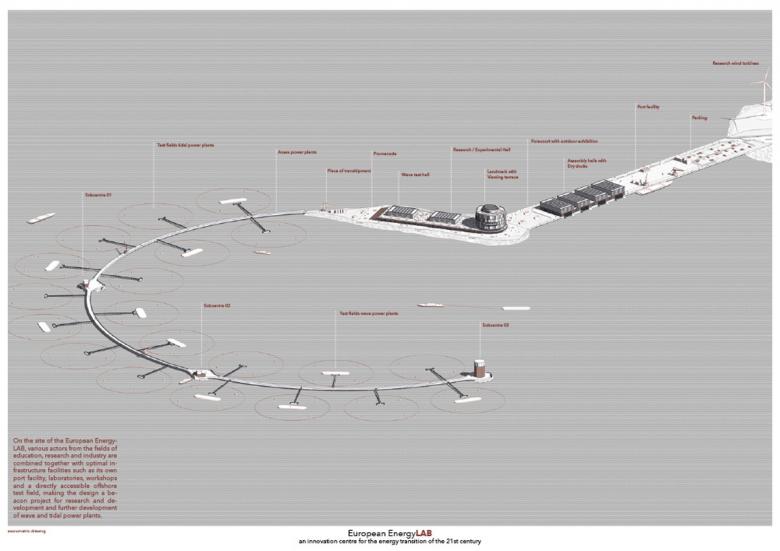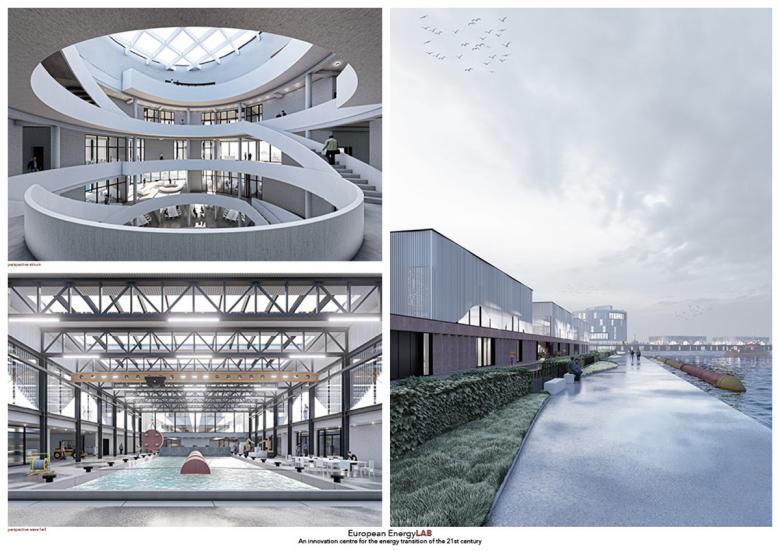European EnergyLAB
Back to Projects listProject Location
Orkney, Scotland, United Kingdom
Topic
Utopia Production and Consumption Systems
Program
Mixed use - Infrastructure & Urban Compact, Facilities, Energy, Public Space, Waterfront
An Innovation Centre for the Energy Transition of the 21st Century
The project deals with the current climate crisis and possible solutions. As a result, a design for a test and research centre for wave and tidal power plants was developed. The developed plant becomes a centre of excellence for the energy transition of the 21st century and serves to tap into the almost unused, renewable energies of the world's oceans.
Supported by capitalism, our society is undergoing rapid technologicalization. With the accompanying industrialization/digitalization, the demand for energy has also increased. Up to now, the energy is predominantly obtained from fossil fuels, which is driving climate change forward. To ensure our continued existence, a radical energy transition is inevitable. Set in this field of tension of the European energy transition, the present work will deal with an almost unused form of renewable energies and infrastructures for their development, research and generation – the power of waves and tides. The developed project becomes an architectural partial solution approach to the climate crisis.
On the site of the European EnergyLAB, various actors from the fields of education, research and industry are combined together with optimal infrastructure facilities such as its own port facility, laboratories, workshops and a directly accessible offshore test field, making the design a beacon project for research and development and further development of wave and tidal power plants. It is located north of Kirkwall on the Bay of Carness. In terms of spatial planning, the European EnergyLAB is divided into three basic elements: plate - island - test field. Already the spatial design of the plant shows its claim as a lighthouse project and ensures a radiant effect. An artificial plate closes the strait between the headland at the Bay of Carness, opening up the offshore island. Starting from the island, a semicircular jetty extends out into the open water in front of the headland. The design consists of two building volumes. On the plate is the first of the two structures - the factory hall - next to the port facility with an adjoining transshipment area. Immediately after delivery of the power plant components via the port facility, assembly takes place in the plant hall. For this purpose, the building offers four hall volumes, which are equipped with dry docks. Once the power plants have been installed in the dry docks, they can be flooded and the power plants float to the adjacent test field. The main building of the plant is located on the island. The building volume is divided into a one-storey, walkable pedestal, on which two hall volumes and a round highlight are placed. The hall volumes include a research hall and a wave test hall. The round highlight is the joint construction of the system. It houses offices, exhibition areas as well as seminar and conference rooms. As the top end of the highlight, a roof terrace open to the public provides an overview of the entire research facility By combining all the competences together with the optimal infrastructures, the European EnergyLAB is one of the innovation centers that will generate solutions for the climate crisis and our future energy supply.






